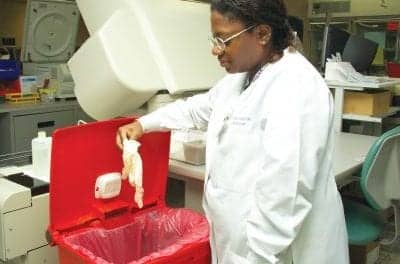
Until recently, methods for the recovery of anaerobic bacteria from clinical specimens and techniques for identifying isolates have been very cumbersome and time consuming. Older methods often lead to the identification and availability for susceptibility testing many days after clinical specimens were first obtained.
Traditional methods
A variety of anaerobic generation systems are available today with one primary functional similarity. They are designed to create an anaerobic environment into which inoculated culture media are housed and incubated.
Anaerobic chamber
Many laboratory scientists consider the anaerobic chamber the best growing environment for anaerobes when stringent anaerobic conditions are required. However, it is not well suited to today’s multifunctional, resource-strained, clinical microbiology laboratory. For example, an anaerobic chamber takes up the space of an entire workstation, an accidental oxygen leak exposes all culture media in the chamber, gas tanks are costly, maintenance is ongoing, and electronic reporting is difficult due to the chamber barrier.
Anaerobic jars
Anaerobic jars incorporate either hydrogen and C02 generator envelopes or evacuation-replacement systems. Potential problems with anaerobic jars include gasket leakage and the need to recharge the catalyst by heat-inactivation after each use. Whenever the jar is opened, all plates in the jar are exposed to oxygen. When incubating media plates for four or five days, several jars in various stages of incubation are employed.
Anaerobic atmosphere-generating pouches
Heat-sealed pouches or bags contain capsules that, when crushed, catalyze the reaction between hydrogen and oxygen, form water, remove oxygen, and thus create an anaerobic atmosphere. Pouch failure is usually due to improper heat-seals. Small colonies of the more fastidious anaerobes cannot be visualized through the bag and must be opened for closer inspection. The cost of using pouches escalates as more bags are used for each subculture and re-incubation.
Oxyrase microbiological products
A newer methodology for growing anerobes, Oxyrase, from Oxyrase Inc., in Mansfield, Ohio, incorporates the mechanisms for achieving anaerobic conditions directly into the culture media. This eliminates the need for barrier apparatus and can significantly reduces time, cost and space requirements.
The technology behind Oxyrase was discovered by the late Dr. Howard Adler and his colleagues at the biology division of Oak Ridge National Laboratory in Oak Ridge, Tenn. They made a discovery that became a new method to grow anaerobic bacteria on solid surfaces without the need for anaerobic housing equipment. They found that cell-membrane fractions derived from Escherichiae coli and related microorganisms were specific for oxygen and reduce it directly to water, creating an anaerobic environment when added to any liquid or solid culture media.
Dr. Adler and his colleagues recognized the practical importance of readily creating anaerobic environments in microbiological media. He and his team had provided a biotechnical solution to a long-standing microbiological problem – how to grow anaerobic microorganisms in an aerobic environment using simple and direct means.
Products available
OxyPlates are pre-poured anaerobic plates with formulations identical to the traditional anaerobic media (e.g. brucella blood agar, Schaedler’s blood agar, kanamycin/vancomycin laked blood agar) with the addition of the Oxyrase enzymatic preparation. Because the burden of achieving anaerobic conditions is placed directly into the media, no barrier apparatus such as jars, pouches, and chambers is required. The plates can be stacked and stored in an ambient air incubator along side aerobic plates. Aerotolerance subcultures can be stored together with the primary anaerobic and aerobic plates for the total patient culture setup. Side-by-side comparison of the aerobic and anaerobic plates allows for early recognition of anaerobic colonies, thus, quicker preliminary reporting. The enzyme continues to reduce the oxygen within the media and in the space between the agar surface and the lid after several exposures throughout the culture workup. Because no extraneous equipment is necessary, anaerobic culture workup is reduced to the same time and workload as aerobic culture workup.
Oxyrase for broth
Traditional broth cultures used as backup for plated media (e.g. thioglycolate or thioglycolate supplemented with hemin and vitamin K1) must be boiled to drive off residual oxygen and cooled before use. By adding two drops of Oxyrase for Broth to each 5ml tube of broth media, anaerobic conditions are established within minutes.
An option for barrier apparatus users
OxyPRAS – plates are pre-reduced anaerobically sterilized media that are used in conjunction with the anaerobic chamber, jars or bags. Oxyrase Inc. has simplified the preparation of PRAS media by first reducing the media with Oxyrase, autoclaving, and then adding Oxyrase again to maintain a reduced state. The plates are then poured and specially sealed. The Oxyrase PRAS plates are unique in that they remain reduced while exposed to ambient air because the Oxyrase in the medium continues to remove oxygen before it can oxidize components in the medium such as blood. Unlike traditionally prepared PRAS plates, OxyPRAS plates maintain a dark, reduced color for several hours after exposure to atmospheric oxygen. For the clinical microbiologist committed to working with anaerobic chambers, jars, or bags the Oxyrase PRAS plate provides an effective medium for isolating and growing anaerobes from patient samples.
Conclusion
Inoculating patient specimens to isolate, identify, and characterize infectious bacteria will continue to be a basic tool of the clinical microbiologist well into the 21st Century. The complexity associated with anaerobic microbiology will not go away, but it has been simplified by the Oxyrase Enzyme System.
Oxyrase Microbiological Products provide a new and convenient approach to working with anaerobes. Lois Pasteur would be proud.
For additional information, Select No. 260 on the reader reply card, or contact Oxyrase at 888-699-3733 or e-mail them at [email protected] .


